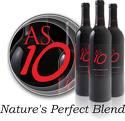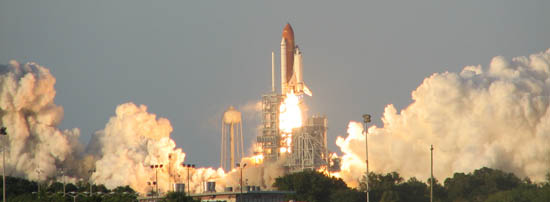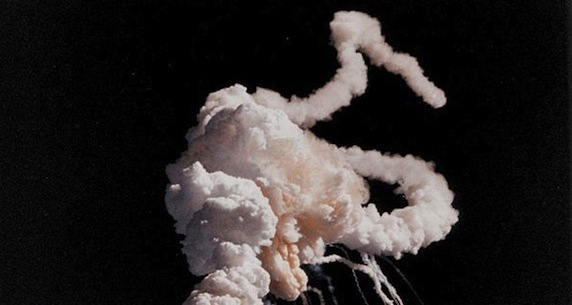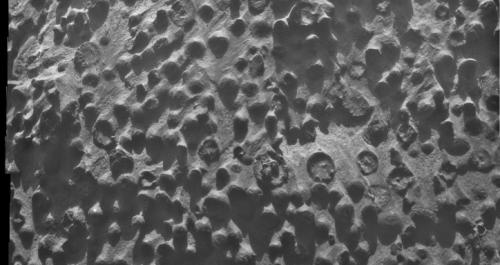NASA
This is part two in a two part series exploring the Challenger disaster. You can find part one here.
With the January 27th launch officially scrubbed and the overnight forecast calling for even more intense cold, the NASA administrators and Morton Thiokol engineers responsible for the Challenger mission faced an increasingly difficult situation. With the launch already rescheduled due to the weather, the shuttle would sit on the launch pad overnight, further chilling the MT built boosters well below the 40°F for which they were launch-certified. Continue reading
In less than two weeks we will quietly pass the 27th anniversary of the space shuttle Challenger disaster-an unnecessary tragedy that cost the lives of seven astronauts on a frosty January morning in 1986. I was lucky enough this week to sit through a talk given by a former employee of Morton Thiokol-the company who manufactured the boosters used on and widely blamed for the Challenger disaster.
The commonly accepted explanation for the accident was that Thiokol’s booster design contained fatal flaws in the O-rings that held the boosters together, and coupled with poor organizational control that prevented the flaws from being addressed. The truth, however, was much greater, and much more troubling to anyone who believed in the greatness of the American space program or the infallible nature of President Ronald Reagan’s administration. Continue reading
The “Curiosity” rover which landed on Mars last month has been hogging the limelight of late, but the “Opportunity” rover which landed on Mars back in 2004 is still active and still getting things done. Continue reading
 During the 1960s there were lots of little kids jumping into newly fallen snow and shouting “First Man On The Moon!” when their boots left a print. Little boys (and some liberated little girls) dreamed of and played at being astronauts. Even if children weren’t old (or sophisticated) enough to follow NASA’s doings, there was I Dream of Jeannie. Popular culture was drenched in all things space-age and planetary. The space program was in the air if you will. Being an astronaut was to a 1960s kid what being a cowboy was to a 1950s kid. Adventure, exploration, and glamour were all packaged into a very cool outfit. Astronauts, like cowboys, even had special food. They had belts that held their lifesaving apparatus. But they also had science. For a kid who loved rocks, or space, or climate, or chemistry, he/she too could dream of being a superhero.
During the 1960s there were lots of little kids jumping into newly fallen snow and shouting “First Man On The Moon!” when their boots left a print. Little boys (and some liberated little girls) dreamed of and played at being astronauts. Even if children weren’t old (or sophisticated) enough to follow NASA’s doings, there was I Dream of Jeannie. Popular culture was drenched in all things space-age and planetary. The space program was in the air if you will. Being an astronaut was to a 1960s kid what being a cowboy was to a 1950s kid. Adventure, exploration, and glamour were all packaged into a very cool outfit. Astronauts, like cowboys, even had special food. They had belts that held their lifesaving apparatus. But they also had science. For a kid who loved rocks, or space, or climate, or chemistry, he/she too could dream of being a superhero.
 Earlier today, the Discovery Channel’s Discovery News tumblr re-blogged a post by The Week Magazine that caught my eye:
Earlier today, the Discovery Channel’s Discovery News tumblr re-blogged a post by The Week Magazine that caught my eye:
A drink formulated by NASA scientists to protect astronauts from the sun’s radiation could become a hot-selling, age-defying beauty product. New research suggests that AS10, or “space drink,” can noticeably reduce facial wrinkles and obvious signs of aging in as little as four months.

Fig 1. Hubble True-Color Image of the Cigar Galaxy (M82)
When we gaze into the night sky, we typically see only the tiny white dots of stars surrounded by the vast blackness of an apparently-empty space, but in truth space has far more color and interest than our naked eye can reveal. One of the primary questions that students would ask me when I worked at Summers-Bausch Observatory in Boulder, Colorado, was “What is the magnification power of this telescope?” The answer was between a factor of 10 and 100, depending on which eyepiece was in use. What people need to understand is that a telescope is not a giant microscope turned upside down. The problem is not that the objects of interest in space are so small, but that they are so faint. Many of the nebulae and galaxies that we observe are nearly the same angular size as the Moon, but the telescope’s advantage is that it can gather a large quantity of light and funnel it right into your eye or onto film. Continue reading
Our top story this morning is your beloved Newsbunny’s left eye being swollen shut after the Stray Cat Attack. Little Furry Bastard. You realize, of course, this means war.
There are other things going on. Continue reading
 I am a space geek. A massive space geek. In sixth grade, I saved up the money I got for delivering our HOA newsletter and bought a telescope, which I used to look at the moon every night, until my dad yelled at me to get off of the roof. I talked my mom into pulling me out of class to drive 60 miles east to Mojave to watch the space shuttle land. We were so far away that it was a white blur distorted by miles of heat coming off the desert floor, but I loved every second of it. I ditched work to see SpaceShipOne take its two trips into space. On Friday, weather permitting, the longest program in the short history of spaceflight is coming to a close. Why am I not unhappy about that? Continue reading
I am a space geek. A massive space geek. In sixth grade, I saved up the money I got for delivering our HOA newsletter and bought a telescope, which I used to look at the moon every night, until my dad yelled at me to get off of the roof. I talked my mom into pulling me out of class to drive 60 miles east to Mojave to watch the space shuttle land. We were so far away that it was a white blur distorted by miles of heat coming off the desert floor, but I loved every second of it. I ditched work to see SpaceShipOne take its two trips into space. On Friday, weather permitting, the longest program in the short history of spaceflight is coming to a close. Why am I not unhappy about that? Continue reading

A relatively new technology now allows consumers – that’s you and me, kids! – to take absurdly high-res panoramic photographs. That means you can take a panorama of a forest, and zoom in to see ants on a leaf. Or pictures of cities and zoom in on that guy who always masturbates on his couch by the window. Not that anybody would.
Continue reading


